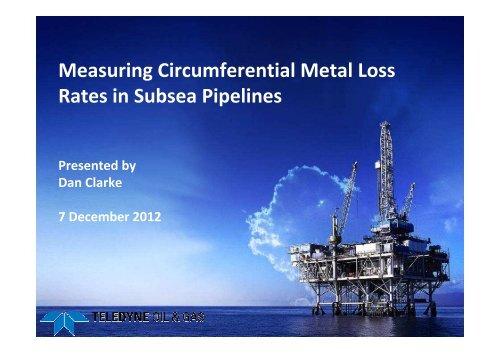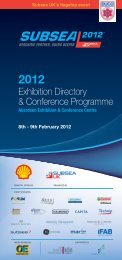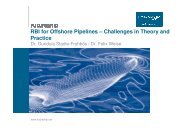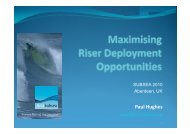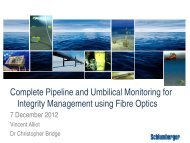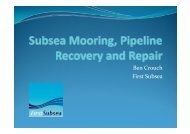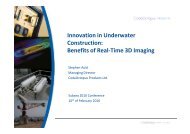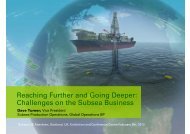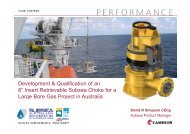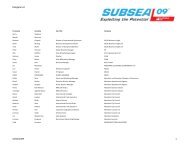Teledyne - Subsea UK
Teledyne - Subsea UK
Teledyne - Subsea UK
You also want an ePaper? Increase the reach of your titles
YUMPU automatically turns print PDFs into web optimized ePapers that Google loves.
Measuring Circumferential Metal Loss<br />
Rates in <strong>Subsea</strong> Pipelines<br />
Presented by<br />
Dan Clarke<br />
7 December 2012<br />
1
Contents<br />
Introduction to Corrosion Monitoring<br />
RPCM Technology Overview<br />
Measurement Performance<br />
Case Studies<br />
2
Introduction to Corrosion Monitoring<br />
Integrity Management<br />
Inspection<br />
Monitoring<br />
Data<br />
Analysis<br />
Mitigation<br />
3<br />
Integrity Monitoring forms an essential part of any Integrity<br />
Management Strategy
Introduction to Corrosion Monitoring<br />
Corrosion Modelling<br />
?<br />
4
RPCM Technology Overview<br />
Electrical Resistance Measurement Principle<br />
Exposed<br />
Protected<br />
S<br />
R<br />
x 0<br />
x<br />
S<br />
b<br />
l<br />
V S<br />
V R<br />
Cumulative Corrosion (x 0 – x) = f(V S / V R )<br />
Corrosion rate = -dx / dt<br />
I<br />
5
RPCM Technology Overview<br />
<strong>Subsea</strong> Corrosion Probe<br />
Basic implementation of high resolution ER measurement.<br />
6
RPCM Technology Overview<br />
Key Attributes<br />
• Full circumference corrosion and<br />
temperature measurement (8 sectors)<br />
• CEION® technology sub-micron<br />
measurement<br />
• Welded or flanged into pipe<br />
• Designed for life of field (>25 years)<br />
• No diameter transition / ‘piggable’<br />
• Typical applications: flowline spools,<br />
export pipelines, onshore<br />
• ‘Online’ device (Modbus, Canbus)<br />
• 18-30VDC continuous,
RPCM Technology Overview<br />
Components<br />
Recoverable Electronics<br />
Drop Protection Frame<br />
PUP Piece<br />
Customer supplied Material<br />
HPHT<br />
(High pressure High Temperature)<br />
PUP Piece<br />
Customer supplied Material<br />
8<br />
Inner spool<br />
Forged Reducers
RPCM Technology Overview<br />
Ring Pair Sensor Operation<br />
Pipe<br />
rings<br />
CRA<br />
flange<br />
• Ceramic coated rings machined from free-issue pipe (usually carbon steel) are<br />
retained between 2 CRA flanges.<br />
• Sample rings inner surfaces are left uncoated.<br />
• Ceramic provides isolation and corrosion resistance.<br />
• Wires attached on outside of sensor rings are fed out to a non-retrievable pod via<br />
9 primary and secondary HTHP penetrators.
I IN,0<br />
1<br />
8<br />
I 1,IN<br />
10<br />
RPCM Technology Overview<br />
Measurement Operation<br />
7<br />
Sample<br />
2<br />
3<br />
Reference<br />
6<br />
4<br />
6<br />
4<br />
5<br />
5<br />
7<br />
Ring Pair Data<br />
1<br />
8 2<br />
Sector Metal<br />
Loss<br />
3<br />
(nm)<br />
I OUT,0<br />
I 1,OUT<br />
• Sample and Reference Rings are in series with one<br />
another and a controlled current source.<br />
• Each Ring Pair operates independently from other Ring<br />
Pairs (allows redundancy).<br />
• For each measurement cycle, current is injected in Mode<br />
0 (4sec), then switched to Mode 1 (4 sec).<br />
• Total measurement cycle is approximately 10 seconds.<br />
• Real time calculation of Metal Loss per sector<br />
1<br />
2<br />
3<br />
4<br />
5<br />
6<br />
7<br />
8<br />
Average<br />
Ref<br />
Temp<br />
(degC)
RPCM Technology Overview<br />
Ring Pair Configurations<br />
Ring Pair Type<br />
Corrosion Type<br />
General<br />
Welded<br />
“Uniform”, TOL,<br />
Mesa, Pitting<br />
Preferential Weld<br />
CRA (e.g. Duplex)<br />
Pre-Pitted<br />
High Sensitivity<br />
Redundant<br />
Pitting<br />
Pitting / Crevice<br />
All<br />
All<br />
• Corrosion mechanisms measured<br />
by changing geometry and ring<br />
material<br />
• 2-4 RPs is the ‘standard’<br />
configuration but more possible.<br />
• Typical Config: 4 RPs, 2 General, 2<br />
Welded<br />
11
Measurement Performance<br />
The Importance of Resolution<br />
Corrosion Rate<br />
1 micron<br />
resolution<br />
Time to Detection<br />
0.1 mm / yr
Measurement Performance<br />
The Importance of Resolution<br />
Resolution (microns)<br />
3.5<br />
3.0<br />
2.5<br />
2.0<br />
1.5<br />
1.0<br />
0.5<br />
0.0<br />
RPCM Metal Loss Resolution vs Pipe Diameter<br />
Filter Time<br />
Constant ~ 3 hours<br />
0 5 10 15 20 25 30 35 40<br />
Pipe Diameter (inches)<br />
300 bar 600 bar<br />
13<br />
• Low pass 1 st order filter with TC ~ 3 hours<br />
• Resolution determined by magnitude of resistance<br />
• Relatively insensitive for large pipe diameters
Measurement Performance<br />
Top-of-Line Corrosion Case Study<br />
2<br />
1<br />
8<br />
3<br />
800<br />
700<br />
RPCM Sector Data<br />
3<br />
7<br />
600<br />
4<br />
5<br />
6<br />
Metal Loss (Microns)<br />
500<br />
400<br />
300<br />
200<br />
Sector 1<br />
Sector 2<br />
Sector 3<br />
Sector 4<br />
Sector 5<br />
Sector 6<br />
Sector 7<br />
• Stratified flow / high temp<br />
• Dissolved CO2 / H2S<br />
• Cold spots are vulnerable<br />
• Organic acids (acetic, HCl)<br />
• BOL protected by inhibitor<br />
100<br />
0<br />
0 100 200 300 400<br />
Days<br />
14
Case Study<br />
CoP Judy Jade North Sea 2001<br />
15<br />
2 x 16” Spool flanged into SSV
Case Study<br />
CoP Judy Jade North Sea 2001<br />
16<br />
Performance of subsea spool after 5 years continuous<br />
operation
Conclusions<br />
• RPCMs have extensive field history<br />
• Widely accepted technology for<br />
subsea pipeline corrosion monitoring<br />
• Full circumferential view<br />
• Versatile configuration – allows<br />
monitoring of: PWC, other alloys,<br />
pitting etc<br />
• Flexible platform for other<br />
measurements<br />
– PT<br />
– Conductivity (EIS)<br />
– Single Phase Flow<br />
• Resolution circa 1 micron (near realtime)<br />
17
18<br />
Thank you for your attention!


